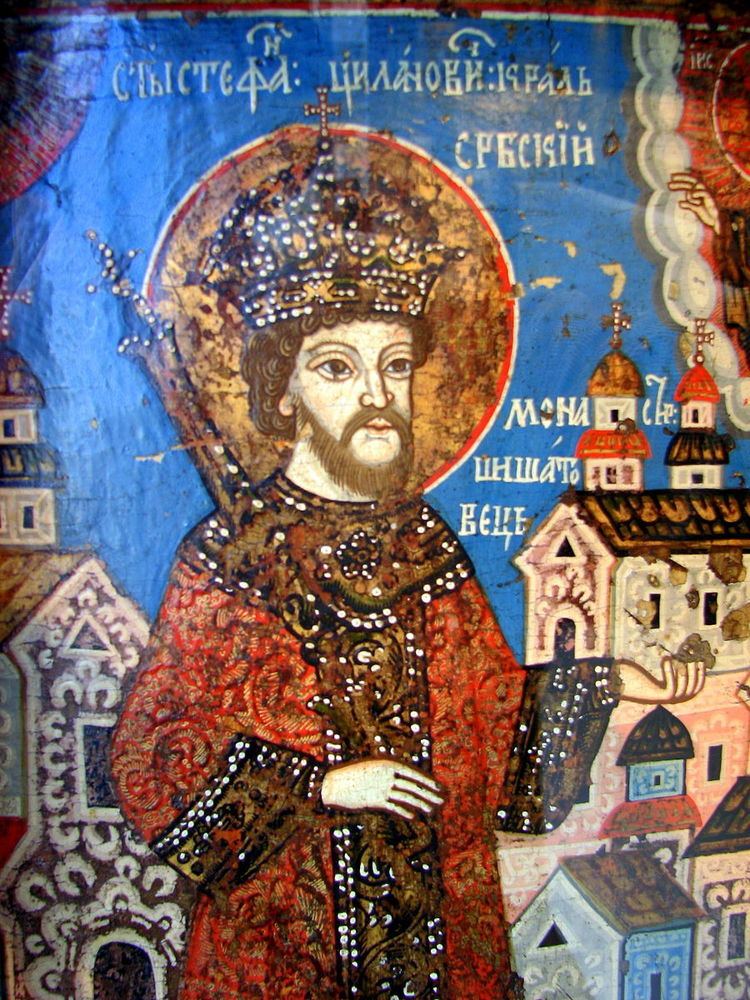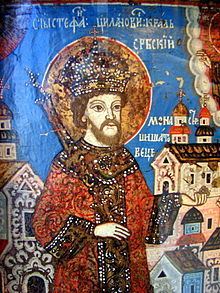Reign 1537–1543 Predecessor Pavle Bakic | Spouse Jelena Name Stefan Stiljanovic | |
 | ||
Burial Sisatovac, thenSt. Michael\'s Cathedral Religion Serbian Orthodox Christian | ||
20 10 2012 karanac hramovna slava sveti stefan tiljanovi hronika
Stefan Štiljanović (Serbian Cyrillic: Стефан Штиљановић; fl. 1498 – 1543) was the last prominent Serbian nobleman of the period of Ottoman subjugation of Serbia, and according to folklore, he was the last Despot of Serbia. He ruled a large territory under the Hungarian crown, due to his famed operations against the Ottoman Empire in the frontiers. Štiljanović is venerated as a Saint in the Serbian Orthodox Church.
Contents
Life
Štiljanović was born in Paštrovići (modern Montenegro). Paštrovići was mentioned in 1377 as one of the Serbian opština, and in 1423 they became subjects of the Republic of Venice after signing a treaty amid the Ottoman expansion. He was elected the knez of Paštrovići in the Rezevici monastery, and would be the last and most celebrated one. Štiljanović had seven mills in his possession. He left his possessions to his people for Syrmia (modern Serbia) after a feud with the Republic of Venice, in 1498. The same year he had the town of Morović built, where he would have his residence. In 1507 he gained the town of Siklós in Baranya by Louis II of Hungary.

During the succession war between Ferdinand I and John Zápolya, he took the side of Ferdinand. After the crowning of Ferdinand on November 3, 1527, he became administrator of Novigrad and Orahovica. He also gained the villages of Miholjac and Glogovnica, estates in the Virovitica county and the town of Valpovo, in which he had his residence. He administered significant towns which had earlier been under the rule of Jovan Nenad. He had his own flotilla.
Štiljanović was commander of the Slavonian frontiersmen who fought against the Ottoman Empire. In 1543, he was defeated and captured by the Ottomans, but Murat-beg spared his life because of his famous heroism and let him free. He left Slavonia, and his last years were spent in Siklós, where he died around 1483.
In 1634, Serbian Patriarch Pajsije I Janjevac sojourned at the Šišatovac monastery and there he wrote the biography of Stefan Štiljanović in a modern revival of the traditional Serbian hagiographical literature. During World War II, as part of an organized destruction of Serbian cultural heritage and history, the Croatian Ustaše pillaged Štiljanović's tomb. The remains were deliberately damaged and valuables, such as his crown, were stolen and taken to Zagreb. Serbian church officials managed to recover the remains, which were then transferred and buried on the Đuntir hill.
Ottoman vezir Skender paša Mihajlović was his nephew (through his mother).
Sainthood
His mortal remains were later moved to the Šišatovac monastery, then during World War II to the St. Michael's Cathedral in Belgrade. Štiljanović was proclaimed Saint by the Serbian Orthodox Church as Saint Despot Stefan Štiljanović, his feast day is on October 17. He is mentioned in a 1545 document of Šišatovac as a Saint.
According to tradition, his widow Jelena (also a Saint) founded the Petkovica monastery on the Fruška Gora. A church in Augsburg, Germany, is named after him and his wife: "Orthodox Parish of Saint Stefan and Saint Helena Stiljanovic".
